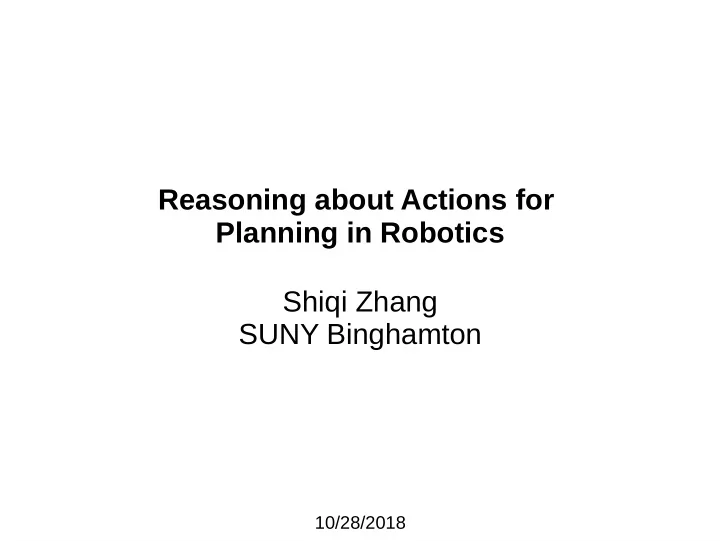

Reasoning about Actions for Planning in Robotics Shiqi Zhang SUNY Binghamton 10/28/2018
2 The SUNY System 64 campuses Four PhD-granting “University Centers” Albany Binghamton – most selective SUNY Buffalo Stony Brook
3 Community — Greater Binghamton Located in New York state Birthplace of IBM (Endicott, NY) Home to several hi-tech companies. One of the safest U.S. midsized cities Low cost of living (12% below U.S. average) Close to major cities
4 Rankings 2018 Rank School # 25Tie Virginia Tech Blacksburg, VA # 29Tie University of Massachusetts— Amherst Amherst, MA # 33Tie Florida State University Tallahassee, FL Michigan State University East Lansing, MI # 33Tie Binghamton University— SUNY Binghamton, NY # 38Tie # 39Tie University of Colorado— Boulder Boulder, CO # 41Tie Stony Brook University— SUNY Stony Brook, NY # 41 University at Buffalo— SUNY Buffalo, NY
5 Computer Science Faculty 33 full-time faculty 8 full professors 8 associate professors 11 assistant professors 6 lecturers 4 adjunct lecturers 3 new faculty members in Robotics/AI, Computer Vision/Machine Learning, and Computer Architecture will join in Fall 2018. Department also has close to 40 teaching Assistants
Reasoning about Actions for Planning in Robotics Shiqi Zhang SUNY Binghamton 6 10/28/2018
Why planning in robotics? ● Complex tasks in the real world require more than one action ● Robot actions (perception and actuation) are unreliable, and sometimes costly Robots need to plan actions to accomplish goals under uncertainty 7
Why reasoning in robotics? ● Robot faces many objects (locations, people, tools, etc) and their properties ● World state estimation with incomplete (qualitative and quantitative) knowledge Robots need to reason to understand the current world state 8
Reasoning (declarative) and planning (probabilistic) Correct and natural Declarative knowledge Incomplete knowledge representation & reasoning Explanation (good for HRI) Strengths Goal-independent Transferability Non-deterministic action outcomes Imperfect perception Unspecified, long horizon Learning from experience (RL) Robo`tics Probabilistic Planning & decision-making Reinforcement learning (RL) 9
Logical-probabilistic reasoning for probabilistic planning, as illustrated in human-robot dialog 10
Robot needs to identify <Coffee, Office 1, Bob>, through spoken dialog Time: 9:00am <Coffee, Office 1, Bob> Rooms: Office 1, Office 2, … Persons: Alice, Bob, Carol, … Items: Coffee, Sandwich, ... 11
“I am a shopping robot, what item do you want?” “Coffee, please” 12
“Coffee, please” “Toffee, please” 13
“Do you want me to buy toffee?” “Coffee, please” 14
Demo video: integrated P-log and POMDP 15 [Zhang, Stone, AAAI 2015]
CORPP: commonsense reasoning and probabilistic planning, a complete example defaults facts world Logical reasoner (LR) Logical reasoner (LR) possible worlds Probabilistic reasoner (PR) Probabilistic reasoner (PR) Probabilistic planner (PP) Probabilistic planner (PP) delivery e.g., coffee > toffee! possible worlds with probabilities 16 [Zhang, Stone, AAAI 2015]
CORPP reasons with logical and probabilistic knowledge, improving robot behaviors 17
Interleaved CORPP (iCORPP) [Zhang, Khandelwal, Stone, AAAI 2017] 18
Interleaved CORPP (iCORPP): Interleaved CORPP (iCORPP): Dynamically Constructed (PO)MDPs for Adaptive Robot Planning Dynamically Constructed (PO)MDPs for Adaptive Robot Planning Example domain: robot navigation Robot locations Areas under sunlight Areas blocked Weather Time 10 2^10 2^10 5 3 More than 2^27 states! 19
Interleaved CORPP (iCORPP): Interleaved CORPP (iCORPP): Dynamically Constructed (PO)MDPs for Adaptive Robot Planning Dynamically Constructed (PO)MDPs for Adaptive Robot Planning Original state space Adaptive Probabilistic planning T = 0 Actions Logical inference T = 1 Actions Probabilistic inference T = 2 Long-term goal This work enables robot behaviors to adapt to exogenous domain changes without including 20 these exogenous attributes in probabilistic planning models
Integrated learning , reasoning , and planning for robot sequential decision-making 21
Human Intention Estimation problem Robot needs to identify human intention (e.g., interested to interact or not) as accurate and early as possible 22
LSTM-CORPP ... ... ... ... Streaming Rules Sensor Data ... ... ... ... Facts Classifier Reasoner LSTM-based Initial Belief Distribution World Probabilistic Planner 23 [Amiri, Shirazi, Zhang, R2K Workshop with KR, 2018]
LSTM-CORPP: preliminary results Accuracy Precision Recall F1 Score Cost Learning 0.61 0.56 0.30 0.39 N/A Reasoning 0.60 0.54 0.62 0.58 N/A Learning + Reasoning 0.58 0.51 0.72 0.60 N/A Reasoning + Planning 0.79 0.67 0.94 0.78 21.6 (CORPP) LSTM-CORPP 0.83 0.74 0.86 0.80 13.1 (Ours) 24
AAAI’19 Tutorial Knowledge-based Sequential Decision-Making under Uncertainty (1/4 day tutorial) Knowledge representation Sequential and reasoning (KRR) decision-making (SDM) 25
Papers ● Shiqi Zhang and Peter Stone, CORPP: Commonsense Reasoning and Probabilistic Planning, as Applied to Dialog with a Mobile Robot , AAAI 2015 ● Shiqi Zhang, Mohan Sridharan and Jeremy Wyatt, Mixed Logical Inference and Probabilistic Planning for Robots in Unreliable Worlds , IEEE Transactions on Robotics (TRO), 31 (3): 699-713, 2015 ● Shiqi Zhang, Piyush Khandelwal and Peter Stone, Dynamically Constructed (PO)MDPs for Adaptive Robot Planning , AAAI 2017 ● Saeid Amiri, Mohammad Shirazi, and Shiqi Zhang, Leveraging Supervised Learning and Automated Reasoning for Robot Sequential Decision- Making , KR'18 R2K Workshop, 2018 ● Keting Lu, Shiqi Zhang, Peter Stone, and Xiaoping Chen, Robot Representation and Reasoning with Knowledge from Reinforcement Learning , arXiv preprint: 1809.11074, 2018 26
How to integrate? Correct and natural Declarative knowledge Incomplete knowledge representation & reasoning Explanation (good for HRI) Goal-independent Transferability Non-deterministic action outcomes Imperfect perception Unspecified, long horizon Learning from experience (RL) Robotics Probabilistic Planning & decision-making Reinforcement learning (RL) 27
Credits: Mohan Sridharan, Peter Stone, Michael Gelfond, Jeremy Wyatt Saeid Amiri, Piyush Khandelwal Thank you! 28
Recommend
More recommend